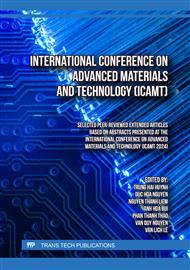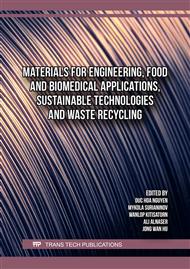[1]
C. Shin, Filtration application from recycled expanded polystyrene, J. Colloid Interfaces Sci. 302 (2006) 267-271.
DOI: 10.1016/j.jcis.2006.05.058
Google Scholar
[2]
S. A. Osemeahon, U. Reuben, E. Emmanuel, Development of adhesive from polystyrene waste, BIOMED Natural Appl. Sci. 2 (2022) 13-24.
DOI: 10.53858/bnas02011324
Google Scholar
[3]
R. V. Sekharan, B. T. Abraham, E. T. Thachil, Utilization of waste expanded polystyrene: Blends with silica-filled natural rubber, Mater. Des. 40 (2012) 221-228.
DOI: 10.1016/j.matdes.2012.03.042
Google Scholar
[4]
G. Ormondroyd, Adhesives for wood composites, in: M.P. Ansell (Ed.), Wood Composites, Woodhead Publishing, 2015, pp.47-66.
DOI: 10.1016/b978-1-78242-454-3.00003-2
Google Scholar
[5]
M. A. R. Lubis, F. P. Sari, R. P. B. Laksana, W. Fatriasari, E. Hermiati, Ambient curable natural rubber latex adhesive cross-linked with polymeric isocyanate for bonding wood, Polym. Bull. 79 (2022) 6745-6757.
DOI: 10.1007/s00289-021-03845-0
Google Scholar
[6]
M.A.R. Lubis, F. Falah, D. Harini, Sudarmanto, A. Kharisma, B. Tjahyono, W. Fatriasari, B. Subiyanto, L. Suryanegara, A.H. Iswanto, Enhancing the performance of natural rubber latex with polymeric isocyanate as cold-pressing and formaldehyde free adhesive for plywood, J. Adhes. 99 (2023) 58-73.
DOI: 10.1080/00218464.2021.1999233
Google Scholar
[7]
J. Kajtna, M. Krajnc, "Design of experiments" analysis in study of solventless UV crosslinkable acrylic pressure sensitive adhesives, Int. J. Adhes. Adhes. 41 (2013) 152-159.
DOI: 10.1016/j.ijadhadh.2012.11.005
Google Scholar
[8]
J. Antony, Design of experiments for engineers and scientists, third ed., Elsevier, 2023.
Google Scholar
[9]
W. Akram, N. Garud, Optimization of inulin production process parameters using response surface methodology, Future J. Pharm. Sci. 6 (2020) 1-9.
DOI: 10.1186/s43094-020-00087-1
Google Scholar
[10]
A. Vohra, T. Satyanarayana, Statistical optimization of the medium components by response surface methodology to enhance phytase production by Pichia anomala, Process Biochem. 37 (2002) 999-1004.
DOI: 10.1016/s0032-9592(01)00308-9
Google Scholar
[11]
R. Asaletha, M. Kumaran, S. Thomas, Thermoplastic elastomers from blends of polystyrene and natural rubber: morphology and mechanical properties, Eur. Polym. J. 35 (1999) 253-271.
DOI: 10.1016/s0014-3057(98)00115-3
Google Scholar
[12]
D. S. Patel, S. Toliwal, J. Patel, Eco-friendly adhesives based on tannin and N, N-bis (2-hydroxy-ethyl) fatty amides (HEFAs) from non-traditional oils for wood bonding, J. Adhes. Sci. Technol. 26 (2012) 2217-2227.
DOI: 10.1163/156856111x610144
Google Scholar
[13]
Y. Ma, Y. Zhang, X. Liu, J. Gu, Synthesis of isocyanate microcapsules as functional crosslinking agent for wood adhesive, J. Adhes. 97 (2021) 38-52.
DOI: 10.1080/00218464.2019.1625039
Google Scholar
[14]
C. M. Obele, M. E. Ibenta, J. O. Ogbuagu, Production and characterization of an ecofriendly polystyrene waste adhesive made with toluene–acetone solvent, Polym. Bull. 81 (2024) 1-19.
DOI: 10.1007/s00289-024-05196-y
Google Scholar
[15]
G. Nakanishi, T. Okamoto, M. Takatani, Thermosetting adhesive based on tannin and poly (N-hydroxymethyl acrylamide), J. Adhes. 84 (2008) 638-652.
DOI: 10.1080/00218460802255517
Google Scholar
[16]
B. Zhang, S. Jiang, G. Du, M. Cao, X. Zhou, Z. Wu, T. Li, Polyurea-formaldehyde resin: a novel wood adhesive with high bonding performance and low formaldehyde emission, J. Adhes. 97 (2021) 477-492.
DOI: 10.1080/00218464.2019.1679631
Google Scholar
[17]
D. Chen, H. Shao, W. Yao, B. Huang, Fourier transform infrared spectral analysis of polyisoprene of a different microstructure, Int. J. Polym. Sci. 2013 (2013) 1-5.
DOI: 10.1155/2013/937284
Google Scholar
[18]
M.L.M. Budlayan, J.N. Patricio, J.P. Lagare-Oracion, S.D. Arco, A.C. Alguno, A. Basilio, F.S. Latayada, R.Y. Capangpangan, Improvised centrifugal spinning for the production of polystyrene microfibers from waste expanded polystyrene foam and its potential application for oil adsorption, J. Eng. Appl. Sci. 68 (2021) 1-11.
DOI: 10.1186/s44147-021-00030-y
Google Scholar
[19]
J. Fang, Y. Xuan, Q. Li, Preparation of polystyrene spheres in different particle sizes and assembly of the PS colloidal crystals, Sci. China Technol. Sci. 53 (2010) 3088-3093.
DOI: 10.1007/s11431-010-4110-5
Google Scholar
[20]
E. Cheng, X. Sun, Effects of wood-surface roughness, adhesive viscosity and processing pressure on adhesion strength of protein adhesive, J. Adhes. Sci. Technol. 20 (2006) 997-1017.
DOI: 10.1163/156856106777657779
Google Scholar
[21]
L. Qie, M. A. Dubé, Manipulation of chain transfer agent and cross-linker concentration to modify latex micro-structure for pressure-sensitive adhesives, Eur. Polym. J. 46 (2010) 1225-1236.
DOI: 10.1016/j.eurpolymj.2010.02.014
Google Scholar



